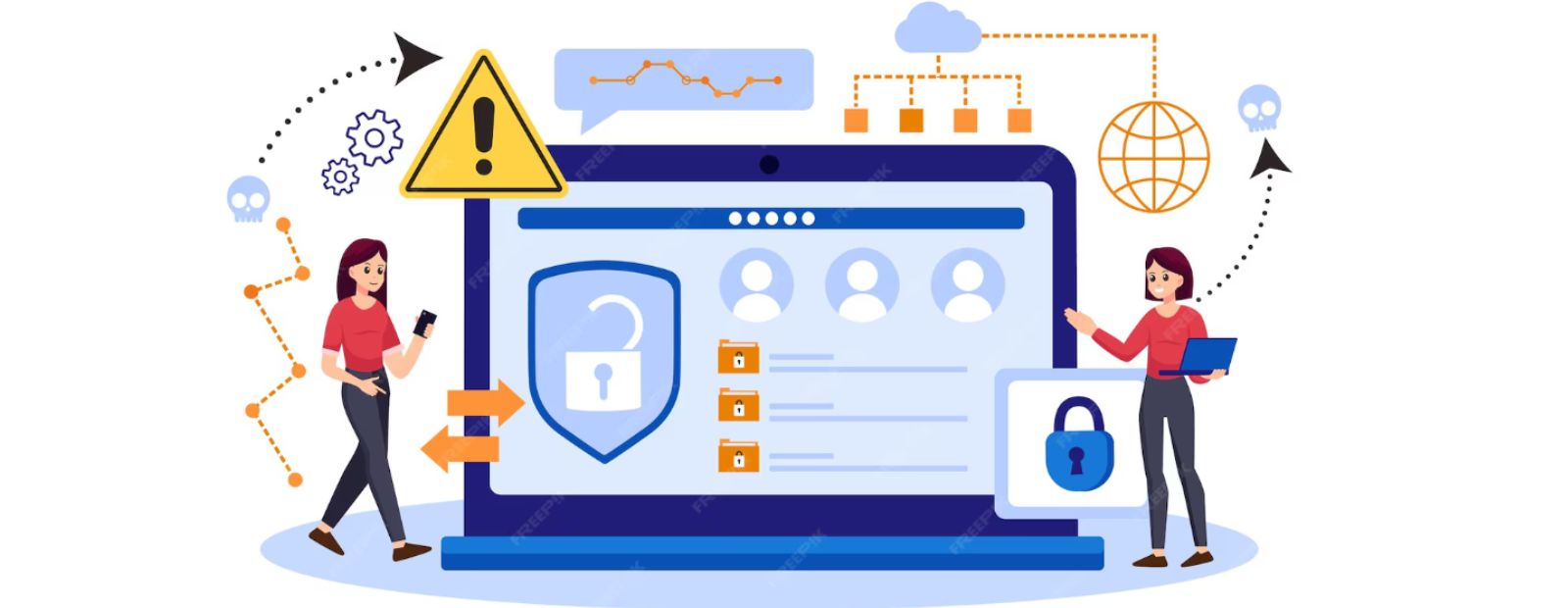Connect with us

AI in Cybersecurity: Enhancing Threat Detection and Response
Cyberattacks are growing smarter and harder to catch. Hackers don’t just target big companies anymore. Small businesses and even individuals are now in their crosshairs. Keeping up with these threats can feel like fighting a never-ending battle.
Here’s the positive update: artificial intelligence is stepping in to assist. AI tools can identify patterns, recognize unusual behaviors, and respond quickly to prevent attacks before they cause harm.
This blog will explain how AI enhances defenses, sharpens threat detection, and makes cybersecurity more efficient. Interested to learn more? Keep reading!
Key Applications of AI in Cybersecurity
AI strengthens digital defenses by identifying threats faster than humans. It gives organizations the upper hand against evolving cyber risks.
Threat Detection and Intelligence
AI-powered systems analyze vast amounts of data to detect cyber threats more quickly than humans. Machine learning models recognize unusual patterns, indicating potential breaches or malware activity promptly. These systems highlight risks before they escalate into significant security incidents.
Cyber threat intelligence tools collect and assess global threat data. They forecast attacks based on historical trends and assist businesses in remaining ahead of hackers. Many organizations seeking advanced Cybersecurity in Chicago leverage such AI-driven intelligence platforms to stay proactive against new and emerging risks.
Phishing and Social Engineering Prevention
Protecting businesses from phishing and social engineering attacks requires effective tools. Cybercriminals often exploit human error through deceptive emails, fake websites, or phone scams.
Artificial intelligence can analyze communication patterns to identify warning signs in real time. For instance, it can detect unusual language in emails that imitate trusted contacts.
Machine learning helps pinpoint suspicious links or attachments before employees click them. It acts like a vigilant guard scanning for hidden traps within messages. “Once you notice the bait, you’re one step closer to neutralizing the hook," as cybersecurity experts say.
Combining AI-driven checks with staff training reduces risks significantly and keeps sensitive information secure from unwanted access. To explore trusted solutions and practical resources on preventing phishing and social engineering threats, click here for more expert insights.
Behavioral Analytics for Insider Threats
Behavioral analytics monitors user actions to detect unusual patterns. It identifies insider threats by observing deviations in activity, such as unauthorized file access or atypical login locations.
For instance, an employee downloading sensitive data at odd hours raises red flags.
Machine learning enhances this process by continuously improving detection capabilities. Businesses can reduce risks without manually reviewing extensive logs. Improved security measures directly support effective identity and access management strategies.
Identity and Access Management (IAM)
Insider threats often take advantage of weak access controls. Identity and Access Management (IAM) enhances defenses by confirming user identities before allowing access to sensitive data or systems.
It ensures that employees, contractors, or third parties only access what they are permitted to view.
Multi-factor authentication (MFA) is a critical component of IAM. Passwords alone are no longer sufficient to counter modern cyber threats. Methods like biometric scans or one-time codes provide additional layers of protection, decreasing breaches caused by stolen credentials.
With IAM, businesses gain stronger control over who accesses their digital environments at any given moment.
How AI Enhances Threat Detection
AI finds unusual patterns in data fast, spots threats early, and keeps hackers on their toes. Keep reading to see how it changes the game.
Machine Learning and Pattern Recognition
Machine learning examines patterns in extensive data to identify threats promptly. It prepares systems to detect harmful behaviors or abnormal activity, strengthening cybersecurity protections over time.
Managed IT services can implement these tools for real-time observation and enhanced threat identification.
Pattern analysis identifies risks by reviewing repeated trends in cyberattacks. For instance, it detects phishing attempts by recognizing fraudulent email formats or questionable links.
Companies that depend on automated responses save time while managing intricate security issues effectively.
Anomaly Detection Algorithms
Pattern recognition helps identify common threats, but anomalies often bypass standard methods. Anomaly detection algorithms work effectively by identifying unusual behavior within systems or networks.
These tools analyze data constantly to detect deviations from normal activity.
For instance, if a user accesses files at odd hours or downloads large amounts of data suddenly, it triggers alerts. Businesses can rely on this to detect insider threats or cyberattacks in real time.
It safeguards sensitive information and enhances overall security measures without depending solely on known threat patterns.
Natural Language Processing for Phishing Detection
Anomaly detection can identify unusual behavior, but phishing attacks often depend on deceptive language. Natural Language Processing (NLP) plays a role in examining text-based communications like emails or messages.
It detects questionable patterns, such as counterfeit domain names, urgent demands, or strange phrasing often associated with phishing schemes.
AI-driven NLP analyzes large amounts of data to detect these warning signs more quickly than humans. It assesses tone and context to categorize potential threats with greater accuracy.
This helps businesses filter harmful content before it reaches employees’ inboxes, significantly lowering risks from cyber threats like email phishing scams.
Benefits of AI-Driven Cybersecurity
AI spots threats faster, keeping systems safer round-the-clock. It lightens the load on security teams by handling repetitive tasks efficiently.
Real-Time Monitoring and Alerts
AI tools monitor systems constantly, scanning for unusual behaviors or cyber threats. They analyze vast amounts of data in real-time to detect vulnerabilities before hackers exploit them.
Businesses benefit from instantaneous notifications when anomalies arise, helping teams respond faster.
Systems with AI reduce human error by automating threat detection and notification processes. Predictive analysis can even foresee potential risks based on patterns found in existing data.
This swift action prevents damage, saving time and resources for IT teams while protecting sensitive information efficiently.
Automation of Threat Responses
Automating threat responses saves time and reduces the workload on security teams. It allows businesses to respond quickly by using pre-determined actions against cyber threats. For instance, intrusion detection systems can isolate suspicious devices or block harmful applications without needing human intervention.
Machine learning enables these systems to act faster than any manual process could manage. Automated responses limit damage while helping IT services focus on more complex tasks. This efficiency is crucial for identifying weaknesses and reducing risks in real-time environments like your business network.
Improved Accuracy and Efficiency
AI-powered systems analyze vast amounts of data in seconds. They identify patterns and vulnerabilities with greater accuracy than human teams alone. This minimizes false alarms, which often burden IT staff.
Machine learning adjusts continuously to emerging threats. It recognizes unusual behavior or anomalies more quickly than manual methods. Automating routine tasks allows experts to concentrate on complex issues, improving overall effectiveness.
Challenges of Implementing AI in Cybersecurity
Implementing artificial intelligence in cybersecurity often requires high-quality data. Poor or incomplete datasets can result in inaccurate threat detection and false positives. Organizations must collect vast amounts of accurate, structured, and diverse information for machine learning models to work effectively.
Collecting this data while adhering to strict privacy laws adds another layer of complexity. Without proper compliance measures, businesses risk significant fines and reputational harm.
Another challenge lies in the technical expertise needed to manage AI-powered systems. Cybersecurity experts with AI knowledge are scarce and costly to hire. Maintaining these tools requires continuous monitoring, regular updates, and thorough testing against evolving cyber threats.
Small businesses may face difficulties with the initial expenses associated with purchasing advanced tools or training staff members on such detailed platforms. Balancing efficiency and affordability becomes an ongoing issue for many managed IT service providers as well.
Conclusion
AI is reshaping cybersecurity. It identifies threats more quickly and responds instantly. Businesses achieve stronger protection against attacks with less effort. While challenges exist, the advantages surpass them. Staying ahead of cyber risks begins with intelligent tools like AI.








